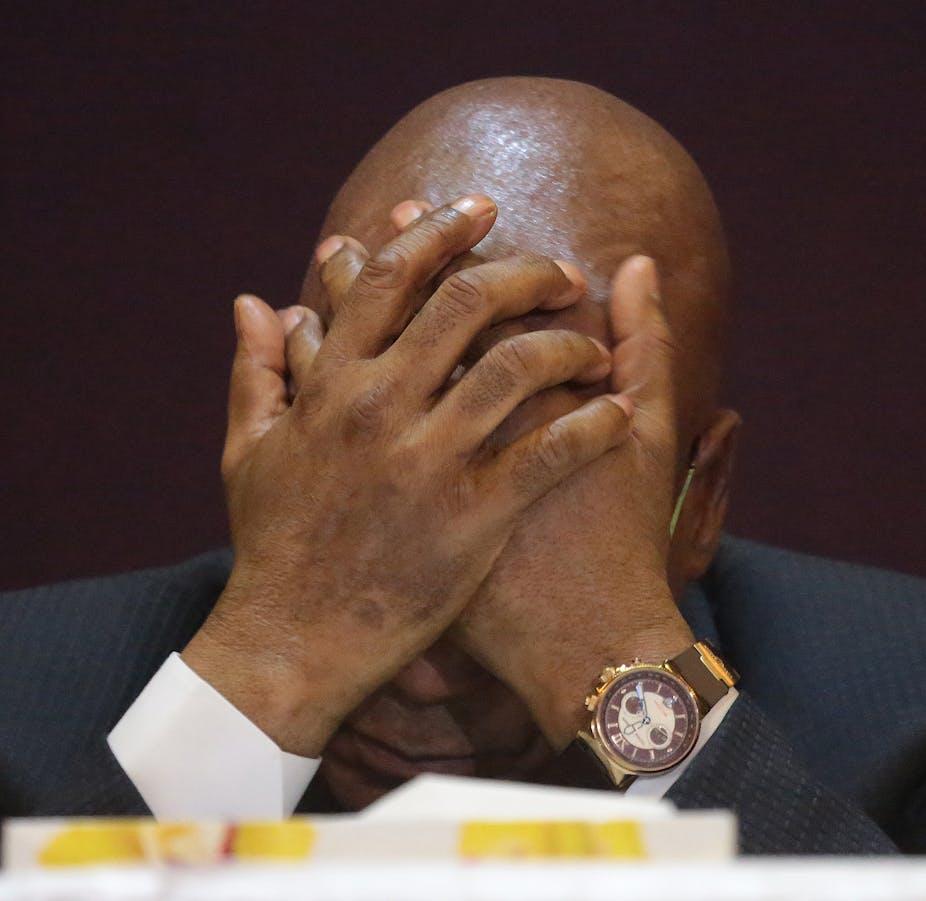South Africa’s African National Congress’s National Executive Committee (NEC) – the body that runs the party between its five-yearly party conferences – has considered a motion to force President Jacob Zuma to step down. Despite increasing tensions within the party over Zuma’s presidency, this is the first time the NEC has considered acting against him. The motion failed but the repercussions for the president, the ANC and the country will reverberate for months and years to come.
An unprecedented number of senior NEC members, including six cabinet ministers, risked their jobs to urge Zuma to resign. The cabinet ministers included tourism minister Derek Hanekom, health minister Aaron Motsoaledi, public works minister Thulas Nxesi and finance minister Pravin Gordhan.
On the other side of the divide were Zuma’s backers which included leaders of three of South Africa’s nine provinces, known as the Premier League and a host of cabinet ministers including the minister of home affairs Malusi Gigaba and sports minister Fikile Mbalula.
Zuma’s supporters fought desperately to avoid the motion being put to the vote at the NEC meeting. This suggests they realised that, for the first time, they weren’t guaranteed a majority. The slimness of the pro-Zuma faction was highlighted by the fact that the NEC meeting was extended from two to three days to enable more Zuma supporters – absent when it started – to fly in to support him.
The debate at the NEC was the latest revolt against Zuma’s leadership. In the governing tripartite alliance the South African Communist Party and some Congress of South African Trade Unions affiliates have both openly criticised him. All backed Zuma for president in 2008. Within the ANC’s wider circle of influence only its Youth League and Women’s League remain Zuma allies.
Parallels with Mbeki’s recall
The attempts to oust Zuma are reminiscent of the sacking of then President President Thabo Mbeki in 2008. The difference is that Mbeki was by then not the president of the ANC. He had been outvoted – and Zuma voted in – at the ANC’s national conference in 2007. A year later the NEC took a decision to recall him as president of the country.
By a strange twist, the NEC has the power to remove the president of the country. But it does not have the power to remove the president of the party.
The only way in which the ANC could remove Zuma would be at an elective conference. These are held every five years. The next one is due at the end of 2017 when Zuma’s term as president of the ANC ends anyway. For Zuma to be removed before that time the elective conference would need to be rescheduled to an earlier date. Though some ANC members are calling for this, it’s highly unlikely to happen.
There are a number of other possible routes the ANC could take to remove Zuma. One is that the party’s disciplinary committee finds him guilty of bringing the ANC into disrepute, or similar charges. This would give it grounds to act against him.
A further possibility is that a motion of no confidence is tabled against Zuma in parliament. This has already happened several times, and has been defeated on each occasion because of the ANC’s overwhelming majority in the house. A no confidence vote would only succeed if the ANC parliamentary caucus took the unprecedented step of walking out when the vote came to the floor.
The possibility that Zuma is removed through the courts is extremely remote. He has, for example, given every indication that he will appeal against remedial action of a judicial commission of inquiry recommended by the former Public Protector in a report on state capture.
Clearly, he will appeal against an unfavourable decision in the High Court to the Supreme Court of Appeal, and then to the Constitutional Court. Judging by past litigation, this will probably take six months. The judicial commission itself will take six months or a year to complete its findings, which Zuma will clearly again take on judicial review. All this will extend beyond the ANC December 2017 conference where Zuma’s successor will be elected.
The reality of power is that removing the national leader of any political party inevitably leads to a long drawn-out fight, and is exceptionally difficult. In the case of Britain’s Conservative Party, it was their parliamentary caucus which removed Margaret Thatcher from office.
Bad for the party, a boon for the opposition
The more drawn-out the struggle to get rid of the scandal-prone Zuma, the worse affected the ANC will be. And the better it will be for opposition parties.
Election campaigners of the main opposition Democratic Alliance openly regard Zuma’s continued presidency as the gift that keeps on giving. The longer he clings to power as state president and ANC president, the more ANC voters will abstain in 2019. And the more DA voters can be mobilised by outrage to go to their polling station.
The DA already stands a good chance of wresting control of Gauteng Province, South Africa economic powerhouse, from the ANC in 2019. The DA is currently redeploying a team of its Cape Town headquarter staff to Johannesburg to wage a two-year election campaign against the ANC.
Beyond the now
Personally, Zuma has less to fear from retirement than most seem to realise. A retired South African president automatically receives a pension equal to 100% of their salary. And there’s a strong likelihood that any ANC-led government would grant him amnesty against possible prosecution for corruption or other possible charges.
The biggest consequence of Zuma’s removal would be that his cronies and agents in state departments and parastatals would be purged. This would mean the end of Zuma’s reign, heralding a new era of honest government and better use of taxpayers’ money.

